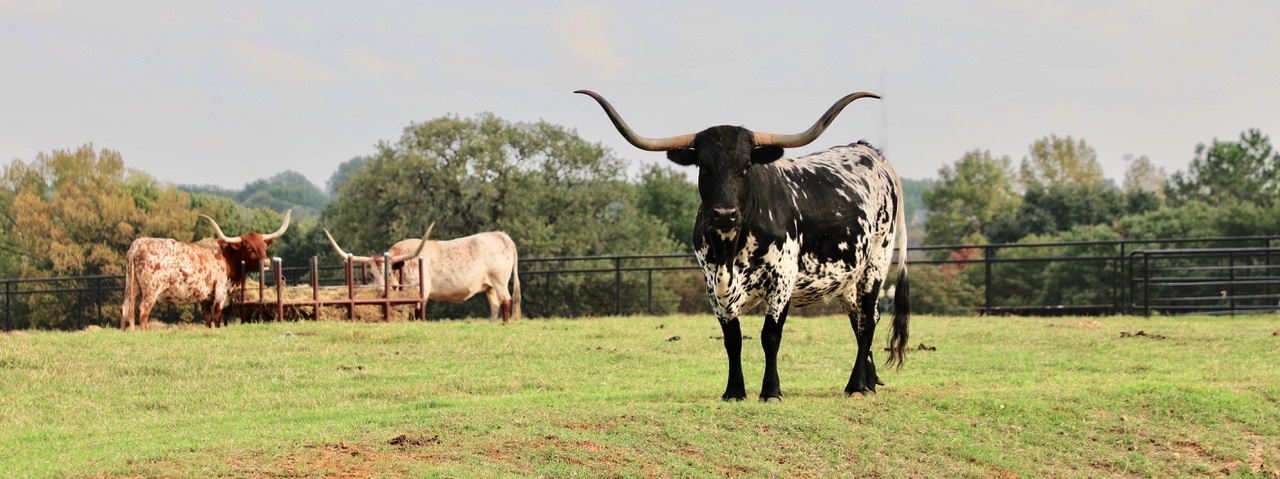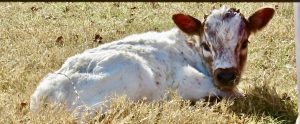
Hayly, far right. She’s the reason I fell in love with longhorns.
In Part 1, I shared a bit about my personal introduction to the Longhorn. As I delved further into their history and learned more about them, I discovered a wonderful article by Michael Casey entitled “History of Longhorns in North America.” Trying to figure out how to paraphrase the material without losing any important points led me to contact Michael, and I was delighted when he agreed to let me republish his words here.
The article is long-ish for a blog post, so I’ve split it into Parts 2 and 3 of this series. The original article includes End Notes that cite Casey’s sources for the article, but End Notes seem a bit academic for a blog post, so I’ve omitted them here. The most frequently cited sources are North American Cattle Ranching Frontiers from the University of New Mexico Press and J. Frank Dobie’s book The Longhorns.
“History of Longhorns in North America”
by Michael Casey
Longhorn cattle have been a part of the history of North America since 1493 when Spanish settlers accompanying Christopher Columbus brought the first few long-horned Iberian cattle with them to the Antilles Islands (Puerto Rico, Cuba, Jamaica, and Hispaniola). Beginning in about 1519, many of those cattle (which had propagated profusely in the interim years) were taken by Antillean settlers when they traveled to Mexico in search of gold and other treasures. Antillean cattle were landed all along the eastern coast of Mexico during the 16th and 17th centuries. The most popular port of entry was Vera Cruz, but they also came ashore as far north as Tampico (less than 200 miles south of the Texas border).
From Vera Cruz, ranches were established quickly, and soon large populations of Iberian longhorns were seen throughout the Panuco Delta as well as south and west of the port of Vera Cruz. From there, long-horned cattle gradually migrated, with Spanish explorers, settlers, and mission priests, north along both the Pacific and Atlantic coasts. The first known cattle in Texas arrived in the early 1700s with Franciscan missionaries as they began to build a chain of missions extending through the San Antonio River valley and out to the present city of Goliad (Texas). Spanish expeditionaries brought sheep, goats, horses, and “horned” cattle on their overland voyages both as food on the hoof to sustain them during their travels and also as seedstock for settlers once having arrived at their destinations.
While entry of long-horned cattle into Texas has been well documented in Frank Dobie’s classic work The Longhorns, it is also established fact that long-horned cattle populated California as early as 1769. Little, however, is known about the long-horned Iberian cattle for the next century other than they typically roamed freely on the large ranchos and mission lands as did cattle throughout the southwestern states as well as California and Texas. Since those early days preceded the introduction of barbed wire fencing, their range also extended well beyond the unsecured boundaries of those properties. It has been estimated that by 1860 about 4,000,000 to 6,000,000 wild long-horned cattle could be found in Texas alone.
While census data for these animals in California has not ever been well documented, we do know that in 1800 there were 153,000 head of “horned cattle” in California and that by 1834 that number had grown to at least 396,000.
By the 1780s the influence of the missions had declined greatly in Texas, and cattle raising largely passed into the hands of private ranchers, many of whom had acquired large land grants from local governors. Cattle ranching quickly spread throughout south Texas and particularly in the region sometimes referred to as the Nueces Strip (a strip of land in south Texas lying between the Nueces River and the Rio Grande). The area between Tampico and Matamoros (just south of the present day Texas border) is cited by Professor Jordan as today’s remaining primary source area for feral “Texas Longhorns.”
Meanwhile, South Carolina became the primary cattle raising colony along the eastern seaboard of America. Although British settlers had brought British breeds to the new world the early cattle population in South Carolina appears to have had significant Iberian influence. That influence traces back to 1704 when British troops and their Creek Indian allies raided Spanish strongholds in Florida in an effort to displace Spanish influence. They captured a number of the Antillean cattle, which had come north to Florida with Spanish settlers from the Antilles in the early 1600s, and they took them to South Carolina where they were crossed with the British cattle which already existed in that colony.
By the end of the 18th century, the “British” cattle had migrated with their owners as far west as Mississippi. While the “cracker cattle herders” (i.e. Carolinian settlers) did reach Texas in the early 1800s, they seem to have initially limited their expansion to the Piney Woods area of western Louisiana and eastern Texas and to the westernmost portions of the longleaf belt in the lower Trinity River valley. More importantly, it would seem that by then the stock they brought with them were largely comprised of Iberian longhorn blood, including longhorns from Florida and also longhorns which had earlier flowed eastward into Louisiana from Texas during the 1780s after a permissive trade edict issued by the Spanish Government. That edict had enabled Texas ranchers to round up and drive a “huge export of cattle and horses to Louisiana … sufficient to cause herd depletion in the lower San Antonio Valley.” Those cattle, which were driven east from Texas into Louisiana, must have been Iberian Longhorns since the influx of Carolinian settlers and their cattle into Texas did not commence until the first decade of the 19th century.
Furthermore, as those Carolinian “cowpenners” continued their progress west along the coastal plains of Texas, it appears that they changed their management styles as well as the makeup of their cattle, adopting the Spanish/Mexican styles of loose management and also Iberian bloodlines in their herds.
Between 1493 and the mid-nineteenth century, feral Longhorns flourished in the Americas, using natural selection principles to develop hardiness, disease resistance, ease of calving, strong mothering instincts, and other traits vital to their survival. What evolved was an animal which could survive in harsh environments, one which had sound legs and could walk miles to water, to breed, and to utilize available forage, and one which could also produce and raise a live healthy calf year after year. The evolutionary process, in which only the fittest could contribute to the gene pool, also produced a body commensurate with the availability of food, gave them hard hooves and lethal horns with which to protect themselves and their young, and provided them with a hardy immune system which made them largely resistant to disease. Furthermore, the cows developed excellent udders in order to be able to successfully feed their young in a harsh land of generally poor forage, and the bulls developed tight sheaths in order to avoid injury in the thick scrub they frequented.
One of the best descriptions of the hardiness that longhorns had developed as feral animals is contained in a passage from Frank Dobie’s classic work, The Longhorns. Dobie described the following episode which occurred about 1850 on Noah Smithwick’s property near Bushy Creek in Texas. Smithwick had a herd of domesticated cattle, but there were also wild longhorns nearby. He described the following:
“Two of the [longhorned] bulls took up with Smithwick’s cattle and became ‘quite domesticated’. About the same time, lobo wolves began to depredate. When the milch [sic] cows and other gentle stock were attacked, they would try to get to the house. The wild cattle, on the other hand, ‘would form a ring around their calves and, presenting a line of horns, would fight the lobos off.”

Hayly’s son.
Pat again here. We’ve all heard of “circling the wagons,” but who knew there was a Longhorn version of that? I’ll pick up the story from here in the next blog post


0 Comments